#types of data analysis
Explore tagged Tumblr posts
Text
What is Information Analysis? Types, Tools, and Importance
Discover what information analysis is, how it works, its types, tools, real-world uses, and its critical role in modern decision-making. What Do You Mean by Information Analysis? An In-Depth Guide to Understanding Information Analysis in the Modern World Introduction: The Age of Information We live in a data-driven era where knowledge is a powerful asset. With vast amounts of data generated…
#business intelligence#data analysis#data interpretation#information analysis#predictive analytics#types of data analysis#what is information analysis
0 notes
Text
Understanding Different Types of Variables in Statistical Analysis
Summary: This blog delves into the types of variables in statistical analysis, including quantitative (continuous and discrete) and qualitative (nominal and ordinal). Understanding these variables is critical for practical data interpretation and statistical analysis.

Introduction
Statistical analysis is crucial in research and data interpretation, providing insights that guide decision-making and uncover trends. By analysing data systematically, researchers can draw meaningful conclusions and validate hypotheses.
Understanding the types of variables in statistical analysis is essential for accurate data interpretation. Variables representing different data aspects play a crucial role in shaping statistical results.
This blog aims to explore the various types of variables in statistical analysis, explaining their definitions and applications to enhance your grasp of how they influence data analysis and research outcomes.
What is Statistical Analysis?
Statistical analysis involves applying mathematical techniques to understand, interpret, and summarise data. It transforms raw data into meaningful insights by identifying patterns, trends, and relationships. The primary purpose is to make informed decisions based on data, whether for academic research, business strategy, or policy-making.
How Statistical Analysis Helps in Drawing Conclusions
Statistical analysis aids in concluding by providing a structured approach to data examination. It involves summarising data through measures of central tendency (mean, median, mode) and variability (range, variance, standard deviation). By using these summaries, analysts can detect trends and anomalies.
More advanced techniques, such as hypothesis testing and regression analysis, help make predictions and determine the relationships between variables. These insights allow decision-makers to base their actions on empirical evidence rather than intuition.
Types of Statistical Analyses
Analysts can effectively interpret data, support their findings with evidence, and make well-informed decisions by employing both descriptive and inferential statistics.
Descriptive Statistics: This type focuses on summarising and describing the features of a dataset. Techniques include calculating averages and percentages and crating visual representations like charts and graphs. Descriptive statistics provide a snapshot of the data, making it easier to understand and communicate.
Inferential Statistics: Inferential analysis goes beyond summarisation to make predictions or generalisations about a population based on a sample. It includes hypothesis testing, confidence intervals, and regression analysis. This type of analysis helps conclude a broader context from the data collected from a smaller subset.
What are Variables in Statistical Analysis?
In statistical analysis, a variable represents a characteristic or attribute that can take on different values. Variables are the foundation for collecting and analysing data, allowing researchers to quantify and examine various study aspects. They are essential components in research, as they help identify patterns, relationships, and trends within the data.
How Variables Represent Data
Variables act as placeholders for data points and can be used to measure different aspects of a study. For instance, variables might include test scores, study hours, and socioeconomic status in a survey of student performance.
Researchers can systematically analyse how different factors influence outcomes by assigning numerical or categorical values to these variables. This process involves collecting data, organising it, and then applying statistical techniques to draw meaningful conclusions.
Importance of Understanding Variables
Understanding variables is crucial for accurate data analysis and interpretation. Continuous, discrete, nominal, and ordinal variables affect how data is analysed and interpreted. For example, continuous variables like height or weight can be measured precisely. In contrast, nominal variables like gender or ethnicity categorise data without implying order.
Researchers can apply appropriate statistical methods and avoid misleading results by correctly identifying and using variables. Accurate analysis hinges on a clear grasp of variable types and their roles in the research process, interpreting data more reliable and actionable.
Types of Variables in Statistical Analysis

Understanding the different types of variables in statistical analysis is crucial for practical data interpretation and decision-making. Variables are characteristics or attributes that researchers measure and analyse to uncover patterns, relationships, and insights. These variables can be broadly categorised into quantitative and qualitative types, each with distinct characteristics and significance.
Quantitative Variables
Quantitative variables represent measurable quantities and can be expressed numerically. They allow researchers to perform mathematical operations and statistical analyses to derive insights.
Continuous Variables
Continuous variables can take on infinite values within a given range. These variables can be measured precisely, and their values are not limited to specific discrete points.
Examples of continuous variables include height, weight, temperature, and time. For instance, a person's height can be measured with varying degrees of precision, from centimetres to millimetres, and it can fall anywhere within a specific range.
Continuous variables are crucial for analyses that require detailed and precise measurement. They enable researchers to conduct a wide range of statistical tests, such as calculating averages and standard deviations and performing regression analyses. The granularity of continuous variables allows for nuanced insights and more accurate predictions.
Discrete Variables
Discrete variables can only take on separate values. Unlike continuous variables, discrete variables cannot be subdivided into finer increments and are often counted rather than measured.
Examples of discrete variables include the number of students in a class, the number of cars in a parking lot, and the number of errors in a software application. For instance, you can count 15 students in a class, but you cannot have 15.5 students.
Discrete variables are essential when counting or categorising is required. They are often used in frequency distributions and categorical data analysis. Statistical methods for discrete variables include chi-square tests and Poisson regression, which are valuable for analysing count-based data and understanding categorical outcomes.
Qualitative Variables
Qualitative or categorical variables describe characteristics or attributes that cannot be measured numerically but can be classified into categories.
Nominal Variables
Nominal variables categorise data without inherent order or ranking. These variables represent different categories or groups that are mutually exclusive and do not have a natural sequence.
Examples of nominal variables include gender, ethnicity, and blood type. For instance, gender can be classified as male, female, and non-binary. However, there is no inherent ranking between these categories.
Nominal variables classify data into distinct groups and are crucial for categorical data analysis. Statistical techniques like frequency tables, bar charts, and chi-square tests are commonly employed to analyse nominal variables. Understanding nominal variables helps researchers identify patterns and trends across different categories.
Ordinal Variables
Ordinal variables represent categories with a meaningful order or ranking, but the differences between the categories are not necessarily uniform or quantifiable. These variables provide information about the relative position of categories.
Examples of ordinal variables include education level (e.g., high school, bachelor's degree, master's degree) and customer satisfaction ratings (e.g., poor, fair, good, excellent). The categories have a specific order in these cases, but the exact distance between the ranks is not defined.
Ordinal variables are essential for analysing data where the order of categories matters, but the precise differences between categories are unknown. Researchers use ordinal scales to measure attitudes, preferences, and rankings. Statistical techniques such as median, percentiles, and ordinal logistic regression are employed to analyse ordinal data and understand the relative positioning of categories.
Comparison Between Quantitative and Qualitative Variables
Quantitative and qualitative variables serve different purposes and are analysed using distinct methods. Understanding their differences is essential for choosing the appropriate statistical techniques and drawing accurate conclusions.
Measurement: Quantitative variables are measured numerically and can be subjected to arithmetic operations, whereas qualitative variables are classified without numerical measurement.
Analysis Techniques: Quantitative variables are analysed using statistical methods like mean, standard deviation, and regression analysis, while qualitative variables are analysed using frequency distributions, chi-square tests, and non-parametric techniques.
Data Representation: Continuous and discrete variables are often represented using histograms, scatter plots, and box plots. Nominal and ordinal variables are defined using bar charts, pie charts, and frequency tables.
Frequently Asked Questions
What are the main types of variables in statistical analysis?
The main variables in statistical analysis are quantitative (continuous and discrete) and qualitative (nominal and ordinal). Quantitative variables involve measurable data, while qualitative variables categorise data without numerical measurement.
How do continuous and discrete variables differ?
Continuous variables can take infinite values within a range and are measured precisely, such as height or temperature. Discrete variables, like the number of students, can only take specific, countable values and are not subdivisible.
What are nominal and ordinal variables in statistical analysis?
Nominal variables categorise data into distinct groups without any inherent order, like gender or blood type. Ordinal variables involve categories with a meaningful order but unequal intervals, such as education levels or satisfaction ratings.
Conclusion
Understanding the types of variables in statistical analysis is crucial for accurate data interpretation. By distinguishing between quantitative variables (continuous and discrete) and qualitative variables (nominal and ordinal), researchers can select appropriate statistical methods and draw valid conclusions. This clarity enhances the quality and reliability of data-driven insights.
#Understanding Different Types of Variables in Statistical Analysis#Variables in Statistical Analysis#Statistical Analysis#statistics#data science
4 notes
·
View notes
Text
considering how terrible just a single Chatgpt prompt is for the environment, seeing this pop up everywhere in everything really has me extra worried for the future of the planet. Like this will cause a lot of harm in other ways too, but also it's immediately causing harm now.
got a major pest problem this year actually




#I might defend the computer scientists here and guess that they were not the driving force behind even creating this iteration of ai#machine learning has been around for a while as an important statistical analysis tool trained on specific data sets#I feel like the idea 'what if the data set we used to train it...was the whole internet?'#was likely pushed more by the tech ceo type people
155K notes
·
View notes
Text
!!!!!!!!
#waiting on the official analysis to be sure#BUT we just finished scanning a mouse and preliminary data supports my claim#Like my boss pointed it out. Which is wild because he’s been so doubtful even though I did weeks of research for this#I feel really stupid in this job because I did a different type of biology and am usually lost when people discuss stuff#So my self confidence has been really low#But if the final analysis concurs the preliminary stuff: then this is the second time I’ve saved this multi-million dollar project#I know my boss gets frustrated having to repeat himself and that I’m sometimes slow to answer because I like to triple check my math#But this reinforces that my slow methodical approach is actually doing good#Like straight up the study would’ve given false negative results for the first issue I solved.#And potentially the same for this second issue#runon post
1 note
·
View note
Text

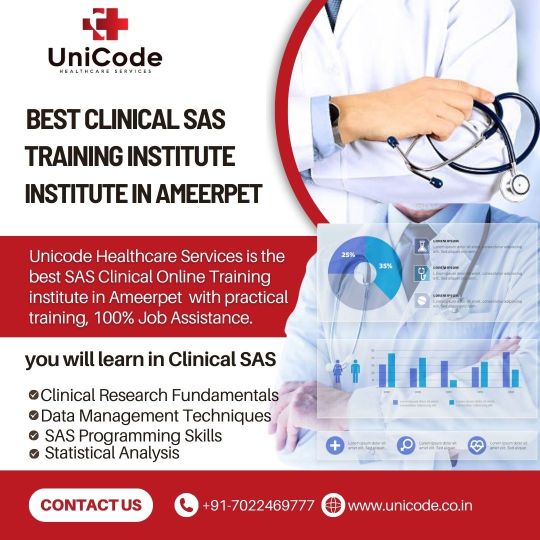

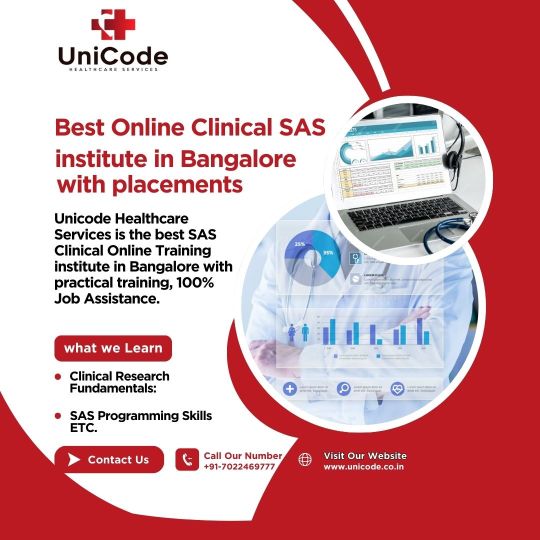
#Best Clinical SAS Training Institute in Hyderabad#Unicode Healthcare Services stands out as the top Clinical SAS training institute in Ameerpet#Hyderabad. Our comprehensive program is tailored to provide a deep understanding of Clinical SAS and its various features. The curriculum i#analytics#reporting#and graphical presentations#catering to both beginners and advanced learners.#Why Choose Unicode Healthcare Services for Clinical SAS Training?#Our team of expert instructors#with over 7 years of experience in the Pharmaceutical and Healthcare industries#ensures that students gain practical knowledge along with theoretical concepts. Using real-world examples and hands-on projects#we prepare our learners to effectively use Clinical SAS in various professional scenarios.#About Clinical SAS Training#Clinical SAS is a powerful statistical analysis system widely used in the Pharmaceutical and Healthcare industries to analyze and manage cl#and reporting.#The program includes both classroom lectures and live project work#ensuring students gain practical exposure. By completing the training#participants will be proficient in data handling#creating reports#and graphical presentations.#Course Curriculum Highlights#Our Clinical SAS course begins with the fundamentals of SAS programming#including:#Data types#variables#and expressions#Data manipulation using SAS procedures#Techniques for creating graphs and reports#Automation using SAS macros#The course also delves into advanced topics like CDISC standards
1 note
·
View note
Text
What is keystroke technology?

An unsettling subject is beginning to surface around how employers monitor how much or how little employees work. Since remote work became popular during the pandemic and businesses started to worry that they couldn’t physically see employees at desks, there has been an increase in digital monitoring. Many said that, as a result, productivity had decreased. Let’s talk about keystroke technology.
The discussion about the technologies businesses use to monitor worker productivity erupted last week when an Australian lady was let go after their monitoring systems revealed she hadn’t spent enough time typing during the workday. According to Business Insider, the 18-year employee of the insurance company used a keyboard for less than 100 working hours in October and again in November. Suzie Cheikho, the woman, has openly denied the accusations.
What is a keylogger, often a system monitor or keystroke logger?
Keyloggers, or keystroke loggers, are surveillance technologies that track and log every keystroke made on a particular device, like a computer or smartphone. It may be based on software or hardware. The latter kind is sometimes called keyboard capture or system monitoring software.
Why do people use keyloggers?
Cybercriminals frequently employ keyloggers as spyware tools to steal valuable company data, login credentials, and personally identifiable information. Nevertheless, there are a few applications for keyloggers that, in specific contexts, might be deemed suitable or moral. Keyloggers, for example, can also be utilised for the following purposes:
By companies to keep an eye on their workers’ computer usage.
Parents monitor the internet use of their kids.
The owners of gadgets monitor any potential illegal activity on their possessions.
By law enforcement organisations to examine computer-related occurrences.
Keystroke tracking software: What Is It?
Keystrokes on employees’ computers are tracked and recorded using keystroke-tracking technology. It records each keystroke a user makes and generates a comprehensive history of their typing actions.
This kind of software is frequently employed for several objectives, such as:
Workers’ Surveillance
Employers can monitor workers’ productivity and activity by implementing keystroke tracking. It can evaluate how workers allocate their time, pinpoint areas needing development, and guarantee adherence to corporate guidelines.
Online Safety
Keystroke monitoring is one security tool they can use to identify and stop unwanted access. The software can detect unusual activity or efforts to breach passwords and other sensitive data by keeping track of keystrokes.
Investigative Forensics
Keystroke tracking can be used in forensic and legal contexts to examine computer user behaviour and gather evidence for inquiries. In situations involving cybercrime or unauthorised access, it is advantageous.
How does it operate?

“keystroke technology” keeps tabs on and gathers information about how employees utilise computers. It is one of the few technologies available to employers to monitor how employees spend the hours they are expected to work more carefully. It records every keystroke an employee makes on their computer.
Thanks to newer features, administrators can now occasionally snap screenshots of employees’ displays. This is the general operation of keystroke tracking software:
Installation: Keystroke tracking software can be installed remotely using malware, phishing scams, or other techniques, or it can be installed on a computer by someone with physical access. It might be purposefully deployed on rare occasions for monitoring—for example, parental control or staff observation.
Hooking into the Operating System: Keyloggers frequently employ methods like hooking into the keystroke handling mechanism of the operating system. Regardless of the application they type in, it enables them to intercept keystrokes as the operating system processes them.
Recording Keystrokes: When installed and turned on, the keylogger records keystrokes. The keyboard captures every key press, including function keys, letters, numbers, symbols, and special keys like Enter, Backspace, and Delete.
Covert Mode: Numerous keyloggers function in stealth mode, which entails running covertly in the background without the user’s awareness. To evade detection by antivirus software and users, they might conceal their files, processes, and registry entries.
Information Recovery:
A database or log file keeps the logged keystrokes. The individual or organisation that installed the keylogger can access it. The keylogger automatically sends recorded data after recording, according to its settings.
Analysis and Misuse: After recording keystrokes, you can examine the data to extract private information such as credit card numbers, usernames, and passwords. Information misappropriation may occur for financial fraud, espionage, identity theft, or other nefarious reasons.
What Issues Does Keystroke Tracking Have With Controversy?
Someone can use keyloggers or keyboard tracking software for controversial purposes, as they can be employed for good intentions just as easily as bad.The following are some critical issues influencing the dispute:
Keystroke tracking presents serious privacy concerns, particularly when people don’t know their manager monitors their typing habits. The possibility of privacy violation may cause unease and resistance.
Unauthorised SurveillanceWithout express authorization, someone can use keystroke tracking software for unauthorized surveillance. This raises moral concerns regarding private property rights and the limits of appropriate monitoring.
Data Security Risks: The management and storage of keystroke data are risks since unauthorised access may lead to financial fraud, identity theft, or other nefarious acts. The acquisition of data raises concerns about its potential misuse.
Workplace Dynamics: When employees are subjected to keystroke tracking in a work environment, trust between them and their employers may be strained. Open communication about monitoring procedures is necessary for sustaining a pleasant work environment.
Ambiguity in Law and Ethics: The debate highlights the necessity for precise laws and moral principles regulating the use of keystroke tracking. Because technology is constantly changing, it is unclear whether current laws can handle new privacy issues.
What Are the Benefits of Keystroke Tracking Software for Businesses?

The company can benefit from implementing keylogging software in the workplace, but it is important to do so responsibly and in accordance with the law. Here are some things to think about:
Enhanced Protection:
Keylogging software is an essential instrument for strengthening security protocols in an enterprise. Keeping sensitive data from unauthorized access and corruption, we identify and resolve issues such as unauthorized access.
Employee Observation:
Keystroke monitoring by employees offers insightful information on their actions and demeanour at work. Employers can use this data to assess worker productivity, spot patterns in behaviour, and identify areas where workers might need more guidance or instruction.
Compliance and Regulations:
By putting keystroke tracking systems in place, businesses can ensure they abide by legal and industry standards for data security and protection. By adhering to set standards, companies reduce the possibility of incurring fines or legal consequences.
Recognizing Insider Threats:
Keystroke monitoring software is crucial for spotting unusual activity or possible insider threats in a company. Organisations can proactively identify and reduce risks posed by internal actors who could compromise sensitive information or carry out unauthorised operations by analysing keystroke data.
Keylogging is an invaluable instrument for investigative purposes when looking into cybersecurity events, fraud, or other illegal activity. Investigators can successfully support their inquiries by gathering evidence and reconstructing events by capturing extensive information about system activity and user interactions.
Safeguarding Private Information:

Keystroke tracking is critical in protecting confidential data, including passwords and private information, from unwanted access. Organisations can put strong security measures in place to stop data breaches and unauthorised disclosures of private information by monitoring user inputs and interactions.
Concluding
Although there is no denying that keystroke monitoring software improves productivity and strengthens cybersecurity, its use requires careful consideration of both practicality and morality. Protecting personal information and fostering employee trust go hand in hand with the ability to improve security and expedite processes
#keystroke technology#typing analysis#biometric authentication#user behavior#security technology#human-computer interaction#machine learning#data security#password alternatives
0 notes
Text
Generative AI for Startups: 5 Essential Boosts to Boost Your Business
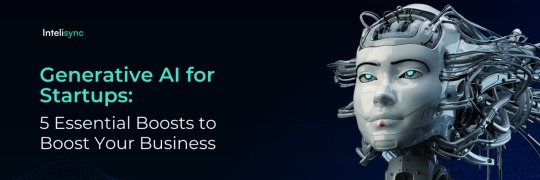
The future of business growth lies in the ability to innovate rapidly, deliver personalized customer experiences, and operate efficiently. Generative AI is at the forefront of this transformation, offering startups unparalleled opportunities for growth in 2024.
Generative AI is a game-changer for startups, significantly accelerating product development by quickly generating prototypes and innovative ideas. This enables startups to innovate faster, stay ahead of the competition, and bring new products to market more efficiently. The technology also allows for a high level of customization, helping startups create highly personalized products and solutions that meet specific customer needs. This enhances customer satisfaction and loyalty, giving startups a competitive edge in their respective industries.
By automating repetitive tasks and optimizing workflows, Generative AI improves operational efficiency, saving time and resources while minimizing human errors. This allows startups to focus on strategic initiatives that drive growth and profitability. Additionally, Generative AI’s ability to analyze large datasets provides startups with valuable insights for data-driven decision-making, ensuring that their actions are informed and impactful. This data-driven approach enhances marketing strategies, making them more effective and personalized.
Intelisync offers comprehensive AI/ML services that support startups in leveraging Generative AI for growth and innovation. With Intelisync’s expertise, startups can enhance product development, improve operational efficiency, and develop effective marketing strategies. Transform your business with the power of Generative AI—Contact Intelisync today and unlock your Learn more...
#5 Powerful Ways Generative AI Boosts Your Startup#advanced AI tools support startups#Driving Innovation and Growth#Enhancing Customer Experience#Forecasting Data Analysis and Decision-Making#Generative AI#Generative AI improves operational efficiency#How can a startup get started with Generative AI?#Is Generative AI suitable for all types of startups?#marketing strategies for startups#Streamlining Operations#Strengthen Product Development#Transform your business with AI-driven innovation#What is Generative AI#Customized AI Solutions#AI Development Services#Custom Generative AI Model Development.
0 notes
Text
I hate to affirm the haters (experienced artists) but wow sitting down and watching art technique videos is really… Wow it really does work. But we CANNOT let the haters know that
#they’re kind of right… practice kind of is essential…… but you will NOT be hearing me say that#anyway I’m actually sitting down to improve form and shape manipulation and I’m like okay okay. wow things are making sense to me#maybe I’m just really high but i feel like I’m making major breakthroughs today#in my artistic pursuit#like as an artist my strong point is technical skill not really imaginative or creative skill#and it’s so fun going back to basics… like actually. makes me want to go back to my graphic design class in college so bad#like I can draw hands perfectly since I’m a semirealism artist but like??? actually understanding each plane and how they connect… fun#I guess it’s just a lot of things that I know in my head but can’t explain#and I’m learning the explanations and I’m like wow 🤔🤔🤔 this is making sense to me#dude the more I sit here and type these notes Im realizing I am so high rn I won’t lie. I won’t lie#I feel like I should go work on the structure I’ve been trying to elucidate and I might make progress#with my third eye opened and all.#like I wanna go run an HSQC-TOCSY right fucking now#anyway though. wow I’m not excited to go back to work Monday but I kind of am just to do data analysis. wow sometimes it is fun#gonna stop rambling now this is entirely off topic#jossisthoughts
1 note
·
View note
Text
Study across multiple brain regions discerns Alzheimer’s vulnerability and resilience factors
New Post has been published on https://thedigitalinsider.com/study-across-multiple-brain-regions-discerns-alzheimers-vulnerability-and-resilience-factors/
Study across multiple brain regions discerns Alzheimer’s vulnerability and resilience factors
An open-access MIT study published today in Nature provides new evidence for how specific cells and circuits become vulnerable in Alzheimer’s disease, and hones in on other factors that may help some people show resilience to cognitive decline, even amid clear signs of disease pathology.
To highlight potential targets for interventions to sustain cognition and memory, the authors engaged in a novel comparison of gene expression across multiple brain regions in people with or without Alzheimer’s disease, and conducted lab experiments to test and validate their major findings.
Brain cells all have the same DNA but what makes them differ, both in their identity and their activity, are their patterns of how they express those genes. The new analysis measured gene expression differences in more than 1.3 million cells of more than 70 cell types in six brain regions from 48 tissue donors, 26 of whom died with an Alzheimer’s diagnosis and 22 of whom without. As such, the study provides a uniquely large, far-ranging, and yet detailed accounting of how brain cell activity differs amid Alzheimer’s disease by cell type, by brain region, by disease pathology, and by each person’s cognitive assessment while still alive.
“Specific brain regions are vulnerable in Alzheimer’s and there is an important need to understand how these regions or particular cell types are vulnerable,” says co-senior author Li-Huei Tsai, Picower Professor of Neuroscience and director of The Picower Institute for Learning and Memory and the Aging Brain Initiative at MIT. “And the brain is not just neurons. It’s many other cell types. How these cell types may respond differently, depending on where they are, is something fascinating we are only at the beginning of looking at.”
Co-senior author Manolis Kellis, professor of computer science and head of MIT’s Computational Biology Group, likens the technique used to measure gene expression comparisons, single-cell RNA profiling, to being a much more advanced “microscope” than the ones that first allowed Alois Alzheimer to characterize the disease’s pathology more than a century ago.
“Where Alzheimer saw amyloid protein plaques and phosphorylated tau tangles in his microscope, our single-cell ‘microscope’ tells us, cell by cell and gene by gene, about thousands of subtle yet important biological changes in response to pathology,” says Kellis. “Connecting this information with the cognitive state of patients reveals how cellular responses relate with cognitive loss or resilience, and can help propose new ways to treat cognitive loss. Pathology can precede cognitive symptoms by a decade or two before cognitive decline becomes diagnosed. If there’s not much we can do about the pathology at that stage, we can at least try to safeguard the cellular pathways that maintain cognitive function.”
Hansruedi Mathys, a former MIT postdoc in the Tsai Lab who is now an assistant professor at the University of Pittsburgh; Carles Boix PhD ’22, a former graduate student in Kellis’s lab who is now a postdoc at Harvard Medical School; and Leyla Akay, a graduate student in Tsai’s lab, led the study analyzing the prefrontal cortex, entorhinal cortex, hippocampus, anterior thalamus, angular gyrus, and the midtemporal cortex. The brain samples came from the Religious Order Study and the Rush Memory and Aging Project at Rush University.
Neural vulnerability and Reelin
Some of the earliest signs of amyloid pathology and neuron loss in Alzheimer’s occur in memory-focused regions called the hippocampus and the entorhinal cortex. In those regions, and in other parts of the cerebral cortex, the researchers were able to pinpoint a potential reason why. One type of excitatory neuron in the hippocampus and four in the entorhinal cortex were significantly less abundant in people with Alzheimer’s than in people without. Individuals with depletion of those cells performed significantly worse on cognitive assessments. Moreover, many vulnerable neurons were interconnected in a common neuronal circuit. And just as importantly, several either directly expressed a protein called Reelin, or were directly affected by Reelin signaling. In all, therefore, the findings distinctly highlight especially vulnerable neurons, whose loss is associated with reduced cognition, that share a neuronal circuit and a molecular pathway.
Tsai notes that Reelin has become prominent in Alzheimer’s research because of a recent study of a man in Colombia. He had a rare mutation in the Reelin gene that caused the protein to be more active, and was able to stay cognitively healthy at an advanced age despite having a strong family predisposition to early-onset Alzheimer’s. The new study shows that loss of Reelin-producing neurons is associated with cognitive decline. Taken together, it might mean that the brain benefits from Reelin, but that neurons that produce it may be lost in at least some Alzheimer’s patients.
“We can think of Reelin as having maybe some kind of protective or beneficial effect,” Akay says. “But we don’t yet know what it does or how it could confer resilience.”
In further analysis the researchers also found that specifically vulnerable inhibitory neuron subtypes identified in a previously study from this group in the prefrontal cortex also were involved in Reelin signaling, further reinforcing the significance of the molecule and its signaling pathway.
To further check their results, the team directly examined the human brain tissue samples and the brains of two kinds of Alzheimer’s model mice. Sure enough, those experiments also showed a reduction in Reelin-positive neurons in the human and mouse entorhinal cortex.
Resilience associated with choline metabolism in astrocytes
To find factors that might preserve cognition, even amid pathology, the team examined which genes, in which cells, and in which regions, were most closely associated with cognitive resilience, which they defined as residual cognitive function, above the typical cognitive loss expected given the observed pathology.
Their analysis yielded a surprising and specific answer: across several brain regions, astrocytes that expressed genes associated with antioxidant activity and with choline metabolism and polyamine biosynthesis were significantly associated with sustained cognition, even amid high levels of tau and amyloid. The results reinforced previous research findings led by Tsai and Susan Lundqvist in which they showed that dietary supplement of choline helped astrocytes cope with the dysregulation of lipids caused by the most significant Alzheimer’s risk gene, the APOE4 variant. The antioxidant findings also pointed to a molecule that can be found as a dietary supplement, spermidine, which may have anti-inflammatory properties, although such an association would need further work to be established causally.
As before, the team went beyond the predictions from the single-cell RNA expression analysis to make direct observations in the brain tissue of samples. Those that came from cognitively resilient individuals indeed showed increased expression of several of the astrocyte-expressed genes predicted to be associated with cognitive resilience.
Expression of the gene GPCPD1 in astrocyte cells is associated with cognitive resilience in people with Alzheimer’s pathology. Here, white arrows indicate instances of GPCPD1 expression (blue) in astrocyte cells (denoted by AQP4 staining in magenta). There is much more expression in tissue from the cognitively resilient person (right).
Image: Tsai Lab/The Picower Institute
Previous item Next item
New analysis method, open dataset
To analyze the mountains of single-cell data, the researchers developed a new robust methodology based on groups of coordinately-expressed genes (known as “gene modules”), thus exploiting the expression correlation patterns between functionally-related genes in the same module.
“In principle, the 1.3 million cells we surveyed could use their 20,000 genes in an astronomical number of different combinations,” explains Kellis. “In practice, however, we observe a much smaller subset of coordinated changes. Recognizing these coordinated patterns allow us to infer much more robust changes, because they are based on multiple genes in the same functionally-connected module.”
He offered this analogy: With many joints in their bodies, people could move in all kinds of crazy ways, but in practice they engage in many fewer coordinated movements like walking, running, or dancing. The new method enables scientists to identify such coordinated gene expression programs as a group.
While Kellis and Tsai’s labs already reported several noteworthy findings from the dataset, the researchers expect that many more possibly significant discoveries still wait to be found in the trove of data. To facilitate such discovery the team posted handy analytical and visualization tools along with the data on Kellis’s website.
“The dataset is so immensely rich. We focused on only a few aspects that are salient that we believe are very, very interesting, but by no means have we exhausted what can be learned with this dataset,” Kellis says. “We expect many more discoveries ahead, and we hope that young researchers (of all ages) will dive right in and surprise us with many more insights.”
Going forward, Kellis says, the researchers are studying the control circuitry associated with the differentially expressed genes, to understand the genetic variants, the regulators, and other driver factors that can be modulated to reverse disease circuitry across brain regions, cell types, and different stages of the disease.
Additional authors of the study include Ziting Xia, Jose Davila Velderrain, Ayesha P. Ng, Xueqiao Jiang, Ghada Abdelhady, Kyriaki Galani, Julio Mantero, Neil Band, Benjamin T. James, Sudhagar Babu, Fabiola Galiana-Melendez, Kate Louderback, Dmitry Prokopenko, Rudolph E. Tanzi, and David A. Bennett.
Support for the research came from the National Institutes of Health, The Picower Institute for Learning and Memory, The JPB Foundation, the Cure Alzheimer’s Fund, The Robert A. and Renee E. Belfer Family Foundation, Eduardo Eurnekian, and Joseph DiSabato.
#000#accounting#aging#Alzheimer's#Analysis#Angular#assessment#astrocytes#author#Biology#Blue#Brain#Brain and cognitive sciences#brain cells#brains#cell#cell types#Cells#cerebral cortex#cognition#Cognitive Decline#cognitive function#comparison#Computational biology#computer#Computer Science#Computer Science and Artificial Intelligence Laboratory (CSAIL)#data#Discoveries#Disease
1 note
·
View note
Text
━━━━━━━━━━
what i need to/should be doing, & i hate it

#typing#writing#i should be writing#reports & emails & everything else#plus data & analysis shit#so much admin#& cleaning#acwri#sciwri#gdi ffs
46 notes
·
View notes
Text
Working in an ophthalmology research lab after all of my years of studying ecology really is a great way to keep my ego in check. Buddy I have no idea what words you’re saying
#I just run the experiment and run data analysis idk what those words mean 😭#the PIs have to do a lecture like once a month and whenever I attend I’m like hm okay yep I have no idea what you’re saying#the what cells? the what? noooo not another new type of cell to me I’m still tryna figure out the last one you said#stop saying ischemia I’ve googled it four times but can’t remember what it means!!!
0 notes
Text
Unlock the power of data analysis with insights from our comprehensive guide! Join Researchers.me and stay at the forefront of analytics.
Read More : https://www.researchers.me/blog/research-of-data-analysis-and-different-types-of-analysis/
0 notes
Text
Thank you so much for putting this all together @ranchthoughts I know it was a ton of work!
I love this data analysis and think it's so interesting (and I also really enjoyed chatting with you about where the lines should be drawn).
I wanted to add on that in addition to this being an interesting breakdown across time and production companies, I think it's also really interesting in terms of what the hard data doesn't tell us. I know when Ranch and I were going back and forth on some of these, one of the things that stood out to me was that this criteria ruled out Wedding Plan, which had at its core marriage equality and acceptance as the entire plot driver of the show (for Yiwah and Marine). It also highlighted Grey Rainbow, which as Ranch rightly noted in their OP was not exactly the ideal plot to hold up as a bastion of progress (though I did love the wedding/family conversations in that show).
All of this is to say that looking at wedding and proposal rep is an important facet of marriage equality representation in Thai QL and it is also only one facet. I've been really blown away by how often BL and GL content bring up marriage equality within shows, and it's something I wish I tracked over time because it started as something that happened occasionally and became an almost ubiquitous occurrence. It's also really difficult to put a quantifiable number on how impactful the reference is; there are big differences between say a casual mention of marriage inequality in a line of dialogue and the speech about marriage inequality by the activist who gets erased in 7 Days Before Valentine. Of the Thai QL I've seen, a few scenes have stood out to me that I want to give shout-outs to:
The protest scene in Not Me directed by Nuchy is one of the most iconic images in support of marriage equality in any QL to date
I always have to give credit to Naughty Babe for setting an established date for when marriage equality would pass (and getting the year right!)
The most depressing prediction in contrast goes to Something in My Room which had a timeskip to the main character's death during which they establish that marriage equality still has not occurred
There are also powerful representations of older, established couples that talk about how they cannot get legally married in Thailand that are a different kind of critical representation, the stand-out being Ai's dads in Ai Long Nhai who get a double-shoutout for being a real-life gay couple who have become two of the faces of the marriage equality movement and have announced a reality tv show for their wedding [links to posts by @pharawee and @singto-prachaya)
I already shouted them out once but I think Yiwa and Marine in Wedding Plan are notable for their wedding/desire to get married driving the entire plot of the show
I want to be extremely clear that this isn't to dismiss or diminish the work in the OP in any way; There's no good way to capture all of this in any one quantitative chart, so I think OP has done a fantastic job highlighting this one facet and breaking it down in really interesting and useful ways. My goal here is just to highlight that readers should be careful about what it does and doesn't tell us, and to encourage folks to think about the other ways that marriage equality has been reinforced and driven forward in QL media in addition to depicting proposals and weddings as one important and impactful facet of the fight that is absolutely worth celebrating and continuing to watch.
Happy marriage equality Thailand! 🌈

A few months ago, @colourme-feral came to me with the idea of cataloguing as many same-sex Thai QL proposals and weddings as we could. And today, to celebrate the bill passing the Senate (and the first post-bill-passing proposal and wedding), I'd like to share with you all our findings! Even though same-sex marriage has not been legal in Thailand until this year (hopefully things will be official in the fall), there have been quite a few same-sex proposals and weddings in Thai QLs throughout the years.
Big thank you to everyone who assisted on this project in some capacity (@airenyah, @bengiyo, @blmpff, @chickenstrangers, @dribs-and-drabbles, @nieves-de-sugui, @twig-tea, @waitmyturtles, @williamrikers) plus all the gif and fanvid makers whose work was instrumental in helping us double check everything (particular shout out to these gifsets by @apathetic-tortoise (1, 2) and this one by @gunsatthaphan).
🏳️🌈🏳️🌈🏳️🌈🏳️🌈🏳️🌈
We found 28 Thai QL shows which featured at least one same-sex proposal (the blue list below) and 15 Thai QL shows which featured at least one same-sex wedding (the green list below).
I was pretty strict with what counted as a proposal or a wedding for the purposes of this project. For example, characters who we know are married but whose wedding we don’t see aren’t counted (like Laws of Attraction’s Maya and Rose, or the unnamed Force and Book characters shown in a “Just Married” car in Vice Versa). There are many shows where there is a ring or someone gets down on one knee but the question is not exactly “popped” (Khun Chai, Star In My Mind Our Skyy 2, etc.), and there are even more shows characters talk at length about commitment and being together forever but there were no mentions of marriage or other details (like rings, etc.) that would specifically suggest it was a proposal (A Boss and a Babe, Ai Long Nhai, Be My Favourite, Cupid's Last Wish, Dark Blue Kiss, Something In My Room, Star in My Mind, Still 2gether, Until We Meet Again, 3 Will Be Free, etc.). Some of these moments might have been intended as a declaration of intent to marry by the characters and the show runners, but they weren’t conclusive enough to be included on this list. Furthermore, I think it’s interesting to see how many shows were, for lack of a better word, explicit in their discussion or portrayal of same-sex marriage (having the characters use the word marriage, showing weddings, etc.), despite being from a time before such a thing was legally possible.
Note: I've listed the shows with the year they started airing for ease, even though some of them did finish airing in another year.
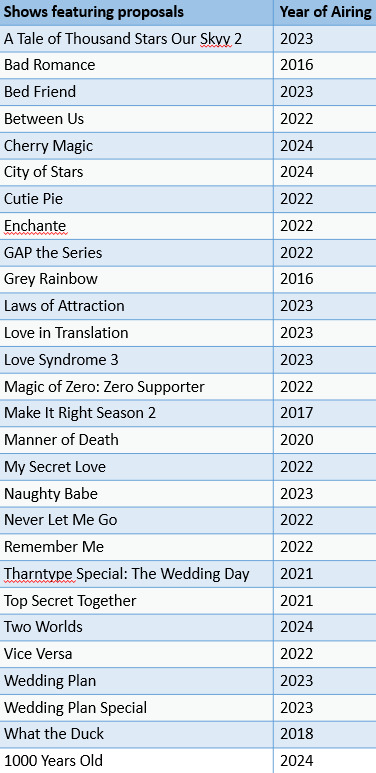

(see alt text for the full lists)
The Quick Facts
The first proposal and the first wedding in our data set both happened in Grey Rainbow episode 4, which aired on May 7, 2016. (though this is not exactly an auspicious wedding to start with, as those who know know)
12 shows featured at least one proposal and one wedding (Cherry Magic, GAP the Series, Grey Rainbow, Laws of Attraction, Love Syndrome 3, My Secret Love, Naughty Babe, Never Let Me Go, Tharntype Special: The Wedding Day, Two Worlds, Wedding Plan, and the Wedding Plan Special).
4 shows feature two same-sex proposals (Cherry Magic, Love Syndrome 3, My Secret Love, and Two Worlds). All these shows also feature a same-sex wedding.
None of the shows in our sample had two same-sex weddings.
The Data Over Time

As you can see, generally same-sex proposals and weddings have become more common in Thai QLs over time, though of course there are more Thai Qls being produced now than in the earlier days.
Note: I'm only looking at shows which aired before the marriage equality bill passed the Senate, so the 2024 data does not include Wandee Goodday or OMG! Vampire. It will be interesting to see if and how the number of same-sex proposals and weddings in Thai QLs increases through 2024 and beyond now that it will become a legal reality.
It is also interesting to consider the production companies behind the shows in our sample. This sample includes 7 GMM shows and 5 Mandee/Domundi shows, plus 1-3 series each from other production companies like Idol Factory, MeMindY, Studio Wabi Sabi, Copy A Bangkok, Jinloe Media Work, TV Thunder, and M Flow Entertainment. In other words, GMM shows make up roughly 23% of the sample, Mandee/Domundi shows are another 16%, and other production companies comprise about 61% of the sample.

Main Couples vs Side Couples
There are 28 shows with proposals in the sample but 32 proposals, because four shows have two proposals each. 26 of these 32 proposals (81%) are between the main characters and 6 of them (19%) are between side characters.
Of the 15 weddings in the sample, 12 (80%) are between main couples and 3 (20%) are between side couples.
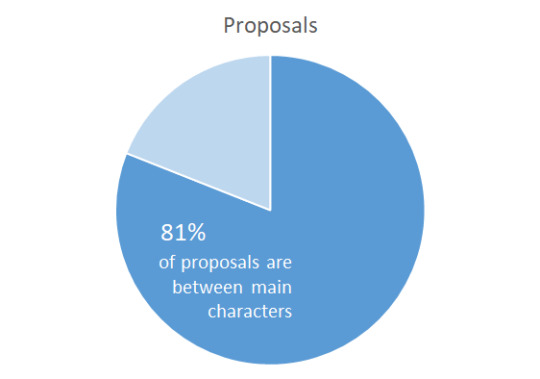

For interest's sake, I also broke this down for GMM and Mandee/Domundi. GMM has 7 proposals in 6 shows, with 5 main couples and 2 side couples popping the question; and 3 weddings (across 3 shows), in which 2 side couples and 1 main couple got married. Mandee/Domundi has 5 proposals in 4 shows, all between main couples, and 3 weddings (across 3 shows), also all featuring main couples.
🏳️🌈🏳️🌈🏳️🌈🏳️🌈🏳️🌈
And now here we are, after the bill has passed the Senate. Congratulations to the Thai queer community, and the happy couples Oyei and Cher from Wandee Goodday and Sen and Run from OMG! Vampire who are the first Thai QL couples to propose and to have a wedding (respectively) after Thailand's marriage equality bill passed the Senate! (The bill passed the Senate on June 18, 2024, and episode 8 of Wandee Goodday aired 4 days later on June 22, followed by episode 6 of OMG! Vampire on June 23.)
I can’t wait to see more same-sex engagements and weddings in Thai shows as we move forward.
#bl meta#gl meta#incredible work op#i love data analysis#yes and#typed so that i can stop thinking it#thank you for tagging me#the secret real goal of this post is to inspire someone else put together an 'iconic moments in the fight for marriage equality in QL' post#because I've already got too many drafts so I can't promise to put that together#but if anyone does want to pick that up and wants to chat through anything please feel free to hit me up!
189 notes
·
View notes
Text
#United Arab Emirates Proprotein Convertase Subtilisin/Kexin Type 9 Market#Market Size#Market Share#Market Trends#Market Analysis#Industry Survey#Market Demand#Top Major Key Player#Market Estimate#Market Segments#Industry Data
0 notes
Text
"A new study reveals the profound ecological effects of wolves and other large carnivores in Yellowstone National Park, showcasing the cascading effects predators can have on ecosystems. In Yellowstone, this involves wolves and other large carnivores, elk, and willows.
The research, which utilized previously published data from 25 riparian (streamside) sites and collected over a 20 year period, from 2001 to 2020, revealed a remarkable 1,500% increase in willow crown volume along riparian zones [note: riparian means in/around rivers] in northern Yellowstone National Park, driven by the effects on elk due to a restored large carnivore guild following the reintroduction of wolves in 1995–96, and other factors...

Pictured: Upstream view of Blacktail Deer Creek in 2005 and 2021, northern range of Yellowstone National Park.
Trophic cascades, the effects of predators on herbivores and plants, have long been a topic of ecological interest. The study quantifies the strength of this phenomenon for the first time using willow crown volume as a proxy for aboveground biomass, demonstrating a significant three-dimensional recovery of riparian vegetation represented by the growth in both crown area and height of established willows.
The strength of the Yellowstone trophic cascade observed in this study surpasses 82% of strengths presented in a synthesis of global trophic cascade studies, underscoring the strength of Yellowstone's willow recovery process. The authors note that there is considerable variability in the degree of recovery and not all sites are recovering.
Even though riparian areas in the western United States comprise a small portion of the landscape, the study has particular relevance since these areas provide important food resources and habitat for more wildlife species than any other habitat type. These areas also connect upland and aquatic ecosystems and are widely known for their high diversity in species composition, structure, and productivity.
"Our findings emphasize the power of predators as ecosystem architects," said William Ripple. "The restoration of wolves and other large predators has transformed parts of Yellowstone, benefiting not only willows but other woody species such as aspen, alder, and berry-producing shrubs. It's a compelling reminder of how predators, prey, and plants are interconnected in nature."
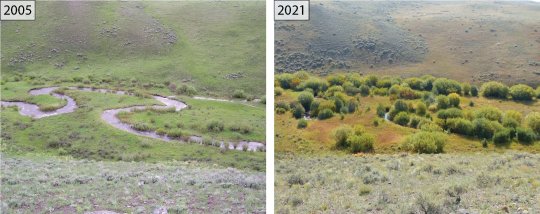
Pictured: An across channel view in 2005 and 2021 of a downstream reach on Blacktail Deer Creek, northern range of Yellowstone National Park.
Wolves were eradicated and cougars driven to low numbers from Yellowstone National Park by the 1920s. Browsing by elk soon increased, severely damaging the park's woody vegetation, especially in riparian areas. Similar effects were seen in places like Olympic National Park in Washington, and Banff and Jasper National Parks in Canada after wolves were lost.
While it's well understood that removing predators can harm ecosystems, less is known about how strongly woody plants and ecosystems recover when predators are restored. Yellowstone offers a rare opportunity to study this effect since few studies worldwide have quantified how much plant life rebounds after large carnivores are restored.
"Our analysis of a long-term data set simply confirmed that ecosystem recovery takes time. In the early years of this trophic cascade, plants were only beginning to grow taller after decades of suppression by elk. But the strength of this recovery, as shown by the dramatic increases in willow crown volume, became increasingly apparent in subsequent years," said Dr. Robert Beschta, an emeritus professor at Oregon State University.
"These improving conditions have created vital habitats for birds and other species, while also enhancing other stream-side conditions."
The research points to the utility of using crown volume of stream-side shrubs as a key metric for evaluating trophic cascade strength, potentially advancing methods for riparian studies in other locations. It also contextualizes the value of predator restoration in fostering biodiversity and ecosystem resilience."
-via Phys.org, February 6, 2025
#wolves#willow tree#trees#yellowstone#yellowstone national park#united states#north america#ecosystem#ecology#ecosystem restoration#wildlife#rivers#riparian#good news#hope
1K notes
·
View notes